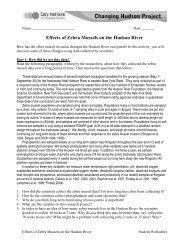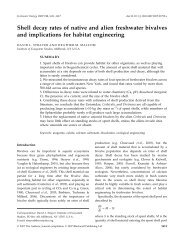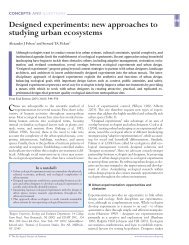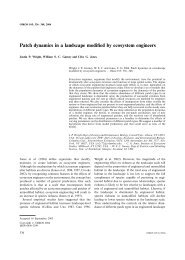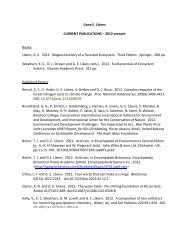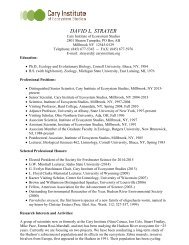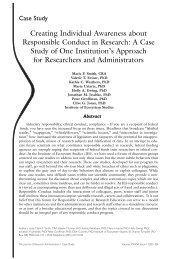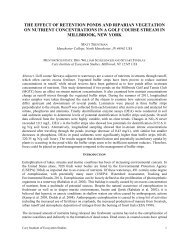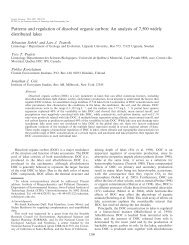Matthew C. Van de Bogert, Stephen R. Carpenter, Jonathan J. Cole ...
Matthew C. Van de Bogert, Stephen R. Carpenter, Jonathan J. Cole ...
Matthew C. Van de Bogert, Stephen R. Carpenter, Jonathan J. Cole ...
Create successful ePaper yourself
Turn your PDF publications into a flip-book with our unique Google optimized e-Paper software.
<strong>Van</strong> <strong>de</strong> <strong>Bogert</strong> et al.Benthic and pelagic metabolismFig. 1. Conceptual diagram of a spatial son<strong>de</strong> <strong>de</strong>ployment. At eachson<strong>de</strong> site (x i) the sensor <strong>de</strong>tects changes in dissolved O 2due to anunknown mixture of benthic and pelagic processes occurring in themixed layer of the lake. In the absence of horizontal dispersion, in shallowwater (where z < z mix) both benthic and pelagic processes would affectthe local sensor. In <strong>de</strong>ep water (where z > z mix) only pelagic processeswould affect the local sensor. At all sites horizontal dispersion tends tohomogenize the O 2signals. Un<strong>de</strong>r the right conditions the spatial profilesof dissolved oxygen changes over a transect of son<strong>de</strong> sites (x 1to x 6) canbe used to separately compute the benthic contributions to GPP and R.of benthic and pelagic habitats to this whole (Va<strong>de</strong>boncoeuret al. 2003). These contributions are sometimes obtained bymeasuring the metabolism of the whole and one of the parts(using bottles or chambers and their associated uncertainties)and inferring the other component by difference (Naegeli andUehlinger 1997; Fellows et al. 2001; <strong>Carpenter</strong> et al. 2005).However, it is not clear whether free-water techniques actuallymeasure the metabolism of the whole system or some part ofit. To date, most estimates of whole-system metabolism haverelied on single sensors in the middle of the pelagic region.However, dissolved oxygen sensors placed in different habitatsin both rivers (Caraco and <strong>Cole</strong> 2002) and lakes (Lauster et al.2006) yield estimates of metabolism that vary with location.In both of those studies, oxygen concentrations were moredynamic in shallow, littoral habitats than in open water. If asingle measurement location were able to provi<strong>de</strong> a completeintegration of whole-ecosystem processes, we would notexpect to see different estimates among sites.Lauster et al. (2006) found that differences in bottle (planktonic)estimates of metabolism between pelagic and littoralhabitats were relatively small, suggesting that planktonicmetabolism was nearly evenly distributed throughout the epilimnion.They also found that although differences were greatestnear-shore, free-water metabolism estimates were greaterthan bottle estimates for both the littoral and pelagic habitats.Lauster et al. (2006) attribute the higher estimates of pelagicmetabolism using the free-water method to benthic sourceswhich are not accounted for by bottle methods. Therefore, afree-water estimate of metabolism from the center of a lake mayinclu<strong>de</strong> some portion (but not necessarily all) of the benthic-littoralsignal. Although the free-water method integrates all signalsthat reach a sensor, the challenge is <strong>de</strong>termining howmuch of the benthic or pelagic signals reach any given location.If localized benthic-littoral processes contribute to wholelakemetabolism in addition to spatially less variable planktonicprocesses, metabolism as measured by free-water methodsshould be greatest near shore (planktonic and benthicprocesses) and lowest at the center of the lake (planktonicprocesses plus advection of some portion of the benthic signal)(Fig. 1). The <strong>de</strong>gree to which measurements near shore arehigher than measurements at the center <strong>de</strong>pends on the magnitu<strong>de</strong>of the benthic signal as well as the <strong>de</strong>gree of horizontalmixing. Given time-series of measurements at only twolocations, even if one is near shore and the other at the centerof the lake, it is not possible to <strong>de</strong>termine how much of themetabolic signal is <strong>de</strong>rived from benthic sources because thereare two unknown factors: the magnitu<strong>de</strong> of benthic metabolismand the <strong>de</strong>gree of advection from the littoral zone to thepelagic. Several series of measurements along a transect, however,might allow one to simultaneously estimate the rate ofhorizontal advection and partition the metabolism signal intobenthic and pelagic sources. Here we use continuous freewatermeasurements of dissolved oxygen at several locationsalong a littoral-pelagic transect to (1) assess the variation inmetabolism estimates among measurement locations, (2) estimatewhole-lake epilimnetic metabolism based on spatiallyexplicit volume-weighted averages of individual measurements,and (3) <strong>de</strong>velop a spatially explicit mo<strong>de</strong>l of wholelakeepilimnetic metabolism that partitions the whole-lake estimateinto benthic and pelagic components.Materials and proceduresData for this study were collected from Peter Lake, locatedat the University of Notre Dame Environmental Research Center(UNDERC) near Land O’Lakes, Wisconsin, USA, over thecourse of two summers (2002 and 2003). Peter Lake is a 2.5-hacircular lake with a mean <strong>de</strong>pth of 6 m, a maximum <strong>de</strong>pth of19 m, and an upper mixed layer during summer stratificationof approximately 3 m (<strong>Carpenter</strong> and Kitchell 1993). In 2002,Peter Lake was fertilized with nitrogen and phosphorus toincrease primary production (<strong>Carpenter</strong> et al. 2005). As a consequenceof the ad<strong>de</strong>d nutrients, average phytoplanktonbiomass increased 10-fold in 2002 relative to other years. Wepresent data for both 2002 (fertilized) and 2003 (not fertilized).Dissolved oxygen and temperature were measured usingYSI mo<strong>de</strong>l 600XLM multiparameter son<strong>de</strong>s calibrated invapor-saturated air before each <strong>de</strong>ployment. Each <strong>de</strong>ploymentconsisted of 4 to 6 son<strong>de</strong>s placed within the epilimnion alonga linear transect from the shore to the middle of the lake.Approximately half of the son<strong>de</strong>s from any <strong>de</strong>ployment werewithin the littoral zone and half in the pelagic. The son<strong>de</strong>closest to shore was placed at a distance from shore where thewater <strong>de</strong>pth was approximately 1 m. Measurements of temperatureand dissolved oxygen were recor<strong>de</strong>d every 5 min at a146



